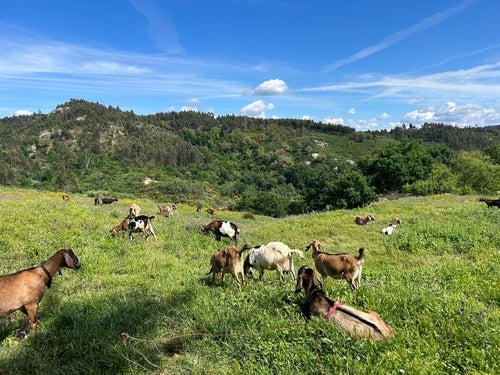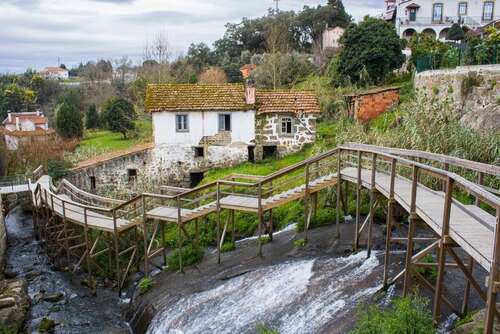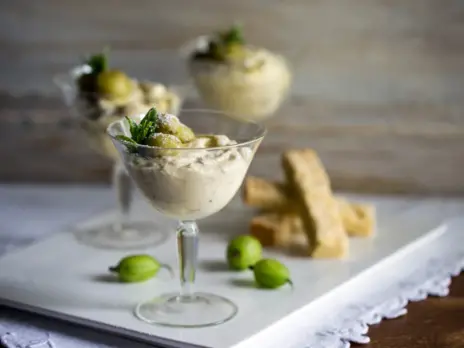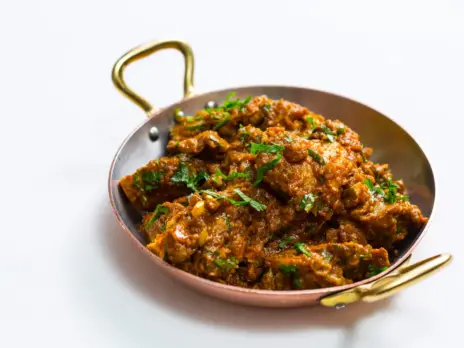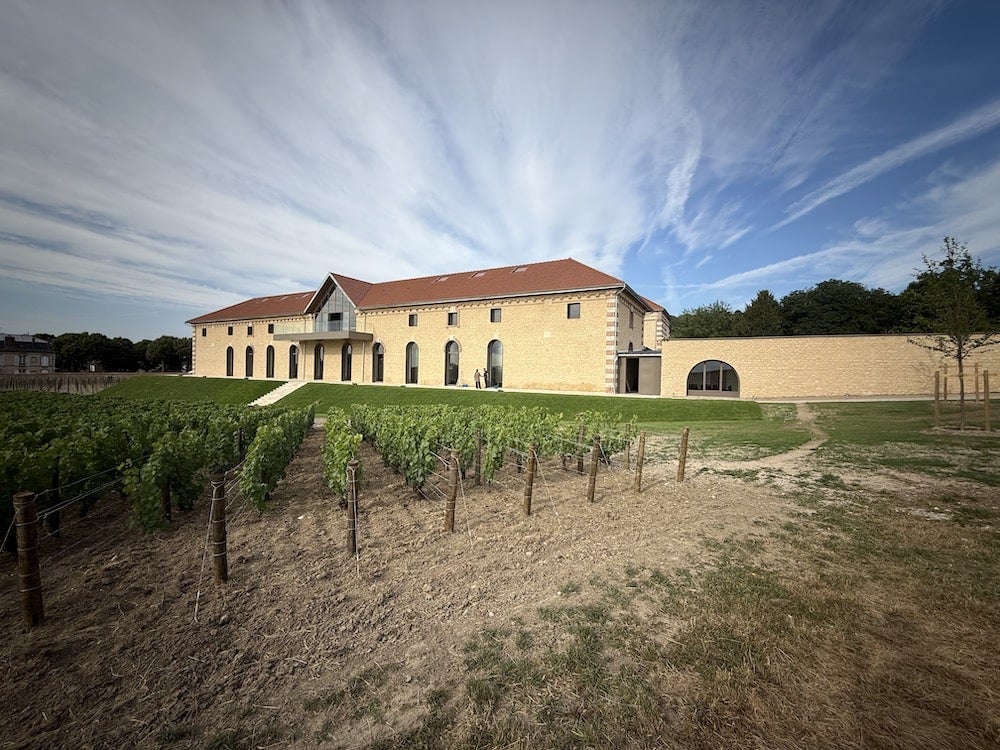
Joanna Simon joins chef de cave Guillaume Lété for an advance preview of Champagne Barons de Rothschild 2019 Le Grand Clos.
You would literally be the first person in the world to taste this wine outside of the members of the Rothschild family and the internal team.” How could anyone resist an invitation to dinner that included those words? Reader, I didn’t. So, 22 days ago, I was that person, dining with the chef de cave of Champagne Barons de Rothschild, Guillaume Lété, and tasting the mold-breaking, oak-vinified 2019 Le Grand Clos ahead of its unveiling today in Champagne to a group of (mostly) importers and its release to the market in September.
The World of Fine Wine breaks the news as Champagne Barons de Rothschild celebrates the 20th anniversary of its founding by the three branches of the family, who joined forces for the first time in their history, at the same time inaugurating its new cellar.
Located in the Côte des Blancs village of Vertus, the new vinification center is in a stone building dating back to 1874 (previously serving as both cellar and family home), which the Champagne house has been renovating for more than a decade, restoring the original vaulted cellars on several levels and creating a new state-of-the-art vat room in the roof structure using traditional methods. The official inauguration is today, but the facility was operational in time for the 2024 harvest and followed on from the opening of a new, purpose-built, eco-friendly, aging-to-dispatch production site in Oger.
The new cuvée and the Vertus cellar are inextricably linked. Le Grand Clos is a Vintage Blanc de Blancs from a single, tiny (despite the name) walled plot of 40-year-old Chardonnay lying contiguous with the cellar in distinctively deep, chalk soil. The 52-are (1.28-acre) premier cru vineyard and building were bought by the Rothschilds in 2013 from the Prieur family (a négociant house with which they are still in touch). Formerly called Clos Prieur, Le Grand Clos sounds almost too good to be true—the sort of thing marketing departments and focus groups dream up—but, pleasingly, the name is authentic; it is in the Napoleonic-era cadastre (land register). It was first planted back in 1910, but was always blended until 2019, when it was vinified separately for the first time. To put its size in perspective: Philipponnat’s Clos des Goisses is 5.83ha (14.4 acres) and Krug’s Clos du Mesnil and Clos d’Ambonnay are 1.84ha (4.5 acres) and 0.68ha (1.68 acres), respectively.
Old moniker; new and very different Champagne. But different from what? Considering the outsize name and reputation and hitherto unprecedented alliance of the founders (today represented by Philippe Sereys de Rothschild of Château Mouton Rothschild, Ariane de Rothschild of Château Clarke–Groupe Edmond de Rothschild, and Saskia and her father Eric de Rothschild of Château Lafite Rothschild), Champagne Barons de Rothschild has kept a relatively low profile during its first 20 years. True, its Champagnes are now sold in 85 countries, and habitués of The Ritz in Paris and London will be familiar with the hotels’ Barons de Rothschild house Champagnes. But comparatively little, surprisingly, has been written about the venture.
Big ambition and reputation, but a softly, softly approach
To put 2019 Le Grand Clos in context, then, we need to go back to the beginning. The house was founded in 2005 when the three families decided to pursue a common ambition together: the creation of a Champagne house. It would have been quicker and easier to buy an existing one, but they say they wanted to create something that would reflect the families’ ethos, including using terroirs of their choosing. It might even have been cheaper to buy a readymade house. Who knows? They don’t reveal how much they have invested, but an inside source says, “The investment is ridiculous!” But probably not for combined Rothschilds.
The first Champagnes were released in 2009. But who, what, where, why? How did the Rothschilds enter the tight world of Champagne and what did its establishment and growers think? Did the name help? “Sometimes, yes, but other times not,” says Guillaume Lété. “Growers wondered, ‘Why are they coming here?’ They were a bit skeptical. The name was a bit frightening for people at first.” After all, it wasn’t just Rothschild, it was the barons with their five-arrowed coat of arms, soon to be embossed on the bottles. My inside source, says, “I was working at [name of prominent grande marque] and the old guard were a bit shitty about it, but they [Champagne Barons de Rothschild] have achieved so much.”
If they are now respected, it is likely to be in large part because they took a softly, softly approach, immersing themselves in the region. In particular, Philippe Sereys de Rothschild and Ariane de Rothschild (wife of the late Benjamin, who died unexpectedly in January 2021) spent a lot of time on the ground. And they hired people from Champagne, rather than bringing in their own. Guillaume thinks this was very important. Indeed, born in Avize, he is one of the home-grown talents. He joined the team aged 23 in June 2011 for his final six-month internship when training as an agricultural engineer, stayed on to become an assistant in the technical department (doing his two-year National Diploma in Enology at Reims at the same time), and was then appointed chef de cave in March 2016.

He was 27. By any standards, it is a meteoric rise, not least because he had no predecessor. The wines were made at La Goutte d’Or cooperative, where, from 2012 to 2016, Guillaume was Adjoint Directeur de Production Groupe Gouttes d’Or Union / Champagne Barons de Rothschild, according to his LinkedIn page. Production in 2011 was very small—just 50,000 bottles from 5ha (12.5 acres)—but it grew tenfold over the next eight years and is now 600,000 bottles. But growth is finite. It won’t go beyond 800,000 bottles, although the new winery has the potential. “We are not even going to be a million bottles,” Guillaume says. Unlike some houses (naming no names), they are not afraid to talk about volumes. Right down to the very last bottle. There are 1,788 bottles of 2019 Le Grand Clos (each one numbered, presented in an oak box, and to be sold on allocation) as well as 6,515 bottles and 800 magnums of the new cuvée launched in October 2024, Triptyque 2018.
The house has had a CEO, Frédéric Mairesse, since 2010 (now also chairman), but there was no chef de cave for the first 11 years. So, who set the style of the Champagne? And why did the Rothschilds choose a young unknown as their cellarmaster? One imagines that there were quite a few hopefuls for the post.
The family apparently had a vision of the style they wanted from the outset: Chardonnay with elegance, finesse, lightness, and drinkability, but also with personality. Even so, it was really Guillaume who set the style, according to Marie Dumas, director of marketing and communications. Why was he chosen? Marie says, simply, that the Rothschilds saw his potential. They liked the idea of having something different. They were starting the house from scratch, and they liked the idea of someone innovative and experimental.
Building from the ground up: a terroir philosophy
Guillaume says that he spent his first years working out which vineyards and which plots worked best and with what vinification. Since 2015 they have bought 8ha (19.77 acres), 6ha (14.83 acres) in the Côte des Blancs and the rest in the Montagne de Reims and the Vallée de la Marne. Almost all are old vineyards in grands and premiers crus, and they account for about 15% of bottled production. They also have 20 partner growers covering 85ha (210 acres), again nearly all in grands and premiers crus and following sustainable viticulture. “Most of the job is inside the vineyards,” he says—explaining to the growers, for example, why they must pick on exactly the day specified, “not the day before or the day after.”
As chef de cave, he has also been very active and creative in the cellar. From the beginning, he worked on the réserve perpetuelle, which dates from the house’s inception and accounts for the majority of the 40% of reserve wines in all the Non-Vintage blends. He soon introduced oak and concrete eggs, to get more complexity and texture, and he works a lot on the élevage.
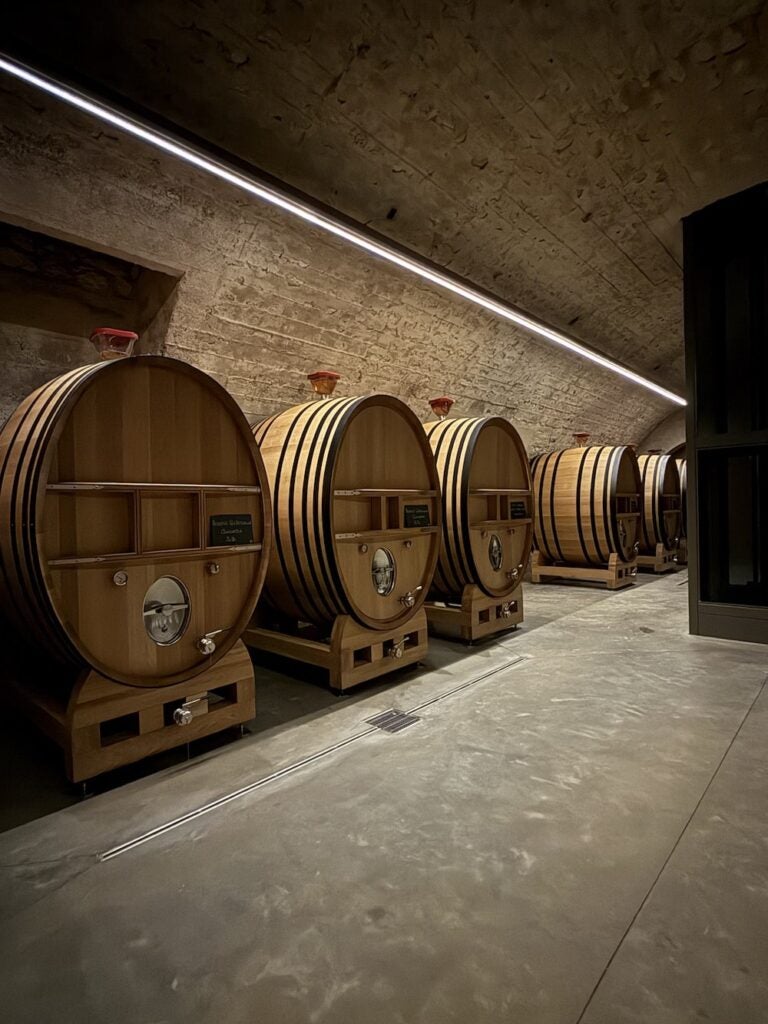
“In Champagne, we don’t speak a lot about élevage,” he says. He bucks the trend, explaining that he does alcoholic and full malolactic fermentation together, so that it’s finished by mid-October, then leaves the wines on lees until the end of May, blending them at the end of spring and bottling, after cold stabilization and a light filtration, in July. A long élevage can tire the wine, so has to be watched carefully, but he does it to build the wine in the mouth. The aim is a delicate nose, fine notes and freshness at the beginning, then volume.
Other key elements of the house style are long aging—between four and more than ten years—and a low, 5–6g/l dosage, with the exception, obviously, of the Brut Nature launched two years ago. It replaced an Extra Brut about which Guillaume is unequivocal: “It was not interesting. It was too oxidative. It was not built for itself, for its own characteristics. It was not the right way. We have to be modern, not continue in the past.”
The Brut Nature, based on the 2019 vintage, was launched in 2023. Another wine he has changed is the rosé. Originally 85% Chardonnay and 15% Pinot Noir, it is now 94% Chardonnay and 6% Pinot Noir. He has also worked a lot on red-wine vinification (which, as it happens, was his first job when he arrived as an intern in 2011, having done previous internships in Bordeaux and California). The strategy for the Pinot Noir red wine is low yields, high maturity, a lot of sorting in the vineyards, cold maceration, and the avoidance of oxidation.
The change in rosé style came in 2018—an excellent vintage in Champagne and a year that Guillaume says was a turning point for the house. It was the debut vintage for Triptyque, a cuvée that he sees as a reflection of “our gradual move to a more terroir philosophy.” Le Grand Clos is another extension of that move—and its combination of oak vinification, barrel-aging, 55 months’ bottle-aging (not especially long), and slightly lower pressure mark a bold departure for a house whose original vision was elegance, finesse, lightness, and drinkability, albeit with personality.
The family is happy with this new expression, says Guillaume, when I ask, and he adds that big decisions are always taken by all three branches of the family. A new Champagne dynasty has been born. It’s a work in progress, but already an accomplished one, under a very creative and energetic chef de cave.
Sold on allocation, the RRP of 2019 Le Grand Clos is €690 per bottle in an oak gift box.
TASTING
Champagne Barons de Rothschild 2019 Le Grand Clos
(100% Chardonnay from Vertus; dosage 2g/l; 1,788 bottles)
The 52-are (1.28-acre) walled plot of 40-year-old Chardonnay in premier cru Vertus was first planted in 1910 but has never before been vinified separately. What makes the site so special, according to chef de cave Guillaume Lété, who has worked for the house for 14 years and “worked on this [wine] for quite a while,” is the distinctively deep, chalk soil, together with very good sun exposure all day and more wind on one side than the other, so that “there are microclimates within it.” The grapes were picked with very high maturity and fermented in barrel (used three times previously), then the wine was aged on fine lees for 13 months in barrel before 55 months in bottle. The pressure is a little less than the standard 6 bar and the bottle I tasted had been disgorged three months earlier. Guillaume describes Le Grand Clos as being “built like a wine,” and his meaning is immediately obvious; one can’t but think of great white Burgundy. There is a feeling of power, volume, and generosity, but contained within a long, controlled, sustained palate. The oak is evident on both nose and palate, still to be fully integrated but in balance and woven with filigree delicacy through buttered hazelnut, sappy, sweet citrus fruit, and chalky, mineral notes. The whole is sleek and creamy, with a racy, saline intensity and length. | 95
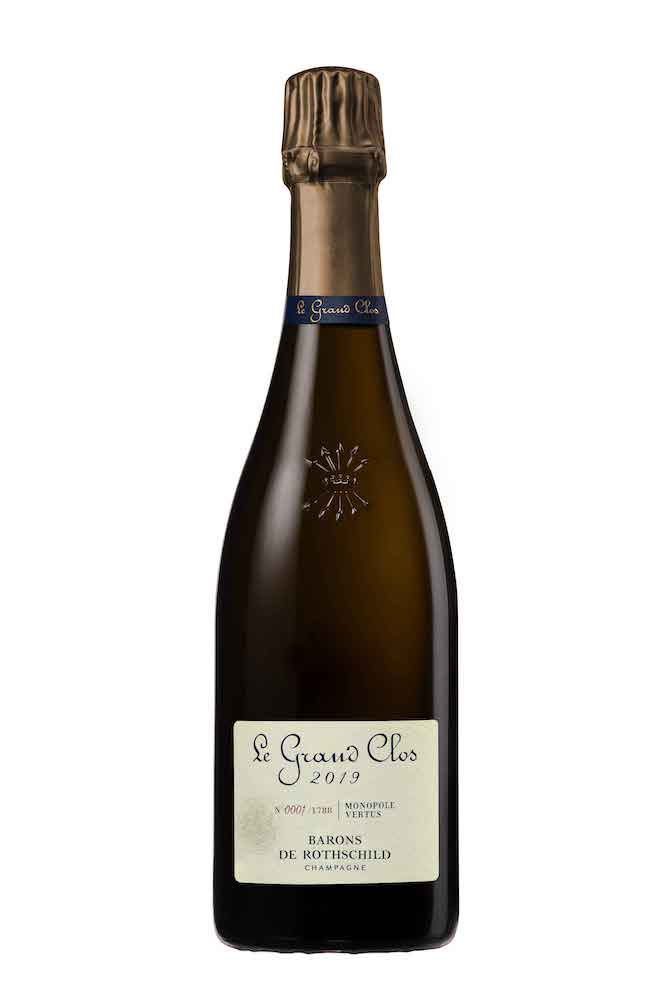
Before tasting Le Grand Clos, I tasted the Non-Vintage Blanc de Blancs and Rosé (both elegant, well-balanced, and attractively detailed) and the three cuvées below from magnum.
Champagne Barons de Rothschild Brut Nature (Magnum)
(60% Chardonnay, 40% Pinot Noir from a total of 2ha [5 acres]; base year 2019, 40% reserve wines; no dosage)
Because there is no added sugar, Guillaume believes that the choice of plots and the élevage are critical. Chardonnay, 10% of which is vinified in barrel and less than 1% in concrete egg, is mainly from Avize, supplemented by Le Mesnil-sur-Oger, Vertus, and Trépail. The Pinot Noir comes from Aÿ, Verzenay, and Ambonnay. The wine was on its fine lees for 6–7 months and then aged for 4 years in bottle. The nose is captivating, fresh, and beautifully pitched, with ripe citrus and apple succeeded by roast almond and sweet nut-biscuits. The palate is defined by its purity, intensity, and persistence but also by its impressive texture and volume. It’s not by any stretch weighty—on the contrary, it’s rather more aerial—but there is a satisfying, mouth-filling quality that zero-dosage Champagnes often lack. | 93
Champagne Barons de Rothschild 2018 Triptyque (Magnum)
(50% Chardonnay from 40 ares [0.99 acres] in Avize, 25% Pinot Noir from 20 ares [0.49 acres] in Ambonnay, and 25% from 20 ares in Aÿ; disgorged June 2024; dosage 5g/l; 6,515 bottles, 800 magnums)
Launched in October 2024, this, the first vintage of Triptyque, marks the house’s gradual move to a more terroir approach and is intended to be a showcase for the three grands crus and, in Guillaume’s words, a new vision of Vintage. “It’s like a photograph inside the vineyards of these three villages,” and “will show a picture of each vintage.” Explaining further, he says the philosophy is to work with “the minerality, the deeper way of Avize, the structure without heaviness of Ambonnay […], with Aÿ the link between the two.” Only the first press is used, and fermentation and aging are in stainless steel, to keep the integrity of the villages. It was 9 months on fine lees, then 5 years in bottle. Pinot Noir is first out of the starting blocks, with ripe fruit, power, and intensity, a rich, creamy texture, and a seductive taste of soft red berries and pâtisserie cream. Then the Chardonnay breaks through in a drift of floral and lemon notes and the upright, salty rigor of preserved lemon. The combination of volume with great finesse and energy is captivating—as is a tantalizing fresh note of chervil. | 93–94
Champagne Barons de Rothschild Rare Collection 2013 Blanc de Blancs (Magnum)
(Grand cru Chardonnay from 2ha [5 acres], mid-slope, mainly in Avize, with Oger, Le Mesnil-sur-Oger, and Cramant; dosage 5g/l; 9,600 bottles, 1,200 magnums)
The 2013, harvested in October, is from a year Guillaume regards very highly as “a vintage like 20 years ago.” Only the first press is used, 90% vinified by parcel in 20hl stainless-steel tanks and 10% vinified in oak. It spent 9 months on fine lees, with regular bâtonnage, before being bottled and aged on lees for 8 years. I am immediately struck by the intensity, the dense, sleek, satin-like texture, and the salinity. There’s a degree of austerity, of verticality, but then delicate lemon, floral, and honeyed roast-almond notes surface, carrying the vertical structure and deep, refined texture forward. With finely layered complexity, freshness, and persistence, this is a very complete wine. | 94–95


